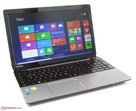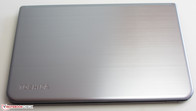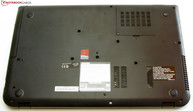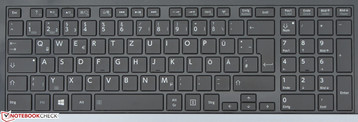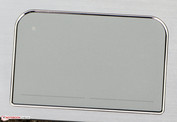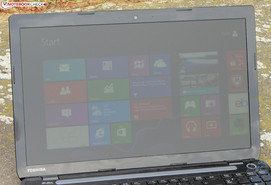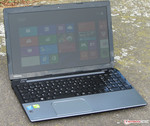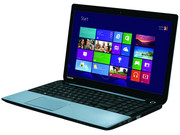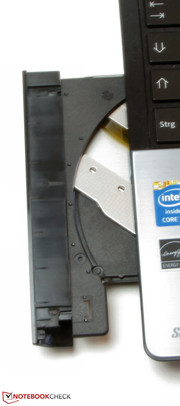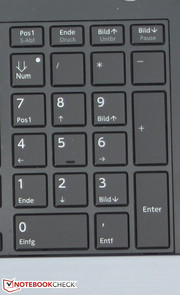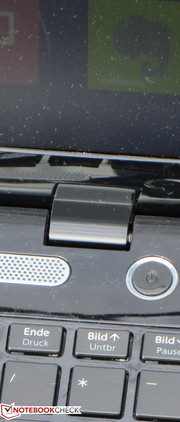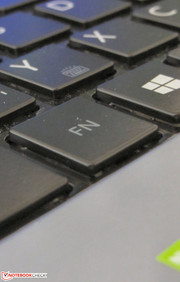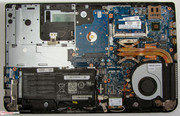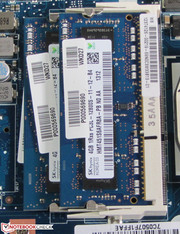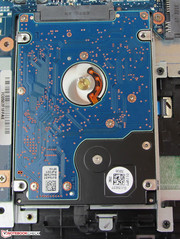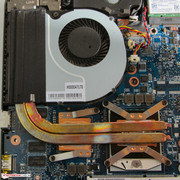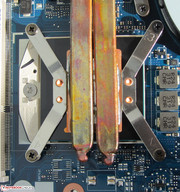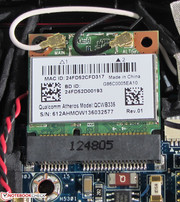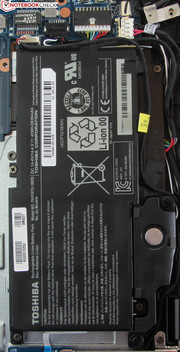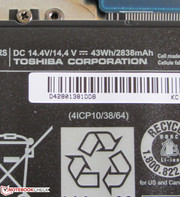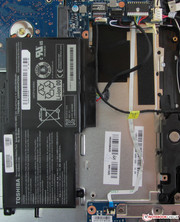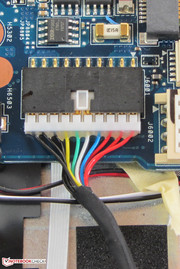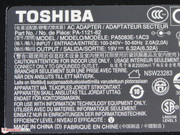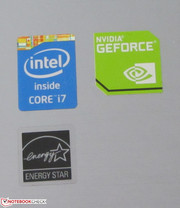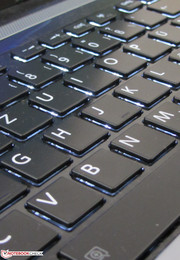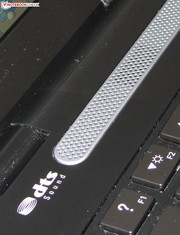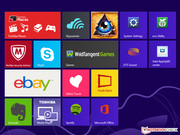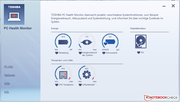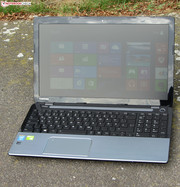Review Toshiba Satellite S50-A-10H Notebook

For the original German review, see here.
Toshiba presents a new line of 15.6-inch all-round laptops with the Satellite S50 range. A Haswell processor alongside a GeForce GPU is to ensure the necessary computing power. Whether the provided device makes a good impression can be read in our review.
We used Asus' N550JV-CN201H (Core i7-4700HQ, GeForce GT 750M) and Samsung's 550P5C-S08DE (Core i7-3610QM, GeForce GT 650M) to classify the laptop.
Case
For a 15.6-inch laptop that sports such powerful hardware, the Satellite is quite compact and handy. Toshiba relies on a mix of materials. The wrist rest and lid's back are made of aluminum. Ice Silver is the name of the color. The display bezel and the base unit are made of plastic. Unfortunately, Toshiba uses glossy plastic here. Asus also mixes metal and plastic in its N550JV and Samsung relies on a full plastic casing in the 550P5C.
The Satellite's base unit proves to be quite rigid. Its upper side barely yields and only dents a bit more above the keyboard in the speakers' area. The stiffness is also satisfactory. As expected, the thin lid can be warped to a greater extent. The rear is sensitive to pressure in several places and image distortions are seen. Opening the lid with one hand is possible.
Connectivity
The connectivity of our three comparison units is largely identical and corresponds to the equipment found in most contemporary laptops. All laptops provide at least two USB 3.0 ports. The N550JV is the only device that does not feature a VGA out. Instead, Asus installs a mini display port. The N550JV is also the only laptop that can read Blu-Ray disks. The interfaces on the Satellite are not placed optimally. The ports on the right are on a level with the wrist rest. It looks better on the left where the ports are located further to the back.
Communication
The Wi-Fi module in the Satellite sports the AR9565 chip from Atheros. It supports the Wi-Fi 802.11 b/g/n standard. Windows' Wi-Fi display exhibited four of five bars in the router's immediate vicinity of approximately 3 meters (~10 feet). The connection was not interrupted two stories below the router (signal strength: approx. 50%). Toshiba also relies on an Atheros chip (AR8171/8175) for Gigabit Ethernet. The laptop even sports a Bluetooth 4.0 module. The webcam shoots quite decent pictures with a resolution of up to 1280x720 pixels.
Accessories
The laptop only comes to the customer with a quick start poster and warranty information.
Operating System and Recovery
Toshiba preinstalls Windows 8 64-bit on the Satellite. A Windows DVD is not included. A set of recovery DVDs can be created via the preinstalled Toshiba Recovery Media Creator. This is recommended so that the system can be reinstalled after a possible hard drive exchange. The Windows 8 recovery system can be started by pressing F11 during the booting process.
Using Windows 7 on the laptop should not be a problem. Toshiba provides the necessary Windows 7 drivers on its website.
Maintenance
The Satellite only features a small maintenance cover that only allows accessing the working memory. The base unit's underside has to be removed to access the other hardware components. That is not a big problem. First, all screws on the underside have to be removed. Then the DVD burner can be pulled out and the underside can be levered off. A spatula from the home improvement center is very helpful here.
The laptop's fan can be taken out for cleaning purposes. Savvy users could also replace the processor. Toshiba installs two working memory banks in the Satellite and both sport a four-gigabyte module. Consequently, the working memory operates in dual-channel mode. Replacing the hard drive would not be a problem either. Toshiba installs a conventional 2.5-inch hard drive with a height of 9.5 mm in our review sample. However, thinner hard drives with a height of 7 mm also fit in the device. Swapping the battery is also possible. It is secured by four screws and is plugged into the motherboard.
Warranty
The Satellite includes a 12-month warranty with pick-up service. The warranty can be upgraded to 24 months free of charge when the laptop is registered by Toshiba. The buyers of Samsung's laptop and the N550JV also receive a two-year warranty. The Satellite's warranty can be upgraded. A three-year on-site warranty costs around 100 Euros (~$133) and 150 Euros (~$200) is charged for four years.
Input Devices
Keyboard
Toshiba equips the Satellite with an illuminated chiclet keyboard. The main keys have a size of approximately 15 x 15 mm. The sleek, flat keys feature an overall medium drop and clear pressure point. The keys' resistance is acceptable but could be a bit crisper. Both the caps lock and num lock keys fortunately have an LED that indicates their status. The keyboard light has three settings: on, permanently on and temporarily on when a key is pressed. The single states can be selected via a function key.
Touchpad
Toshiba installs a sufficiently sized multi-touch ClickPad of approximately 10.7 x 6.7 cm (~4.2 x 2.6 inches). It is a touchpad without dedicated mouse buttons. The entire pad is a key. The pad detects whether the left or right mouse button is pressed according to the finger's position in its lower area. The pad's sleek surface lets the fingers glide over it easily. The different multi-touch gestures can be enabled or disabled in the corresponding configuration menu. Not all gestures are enabled ex-factory. It is possible to disable the entire pad by tapping its upper left corner with a finger. A built-in LED indicates the pad's status. The ClickPad features a short drop and a clearly audible and palpable pressure point.
Display
Toshiba installs a matte, 15.6-inch screen in the Satellite. It works with a native resolution of 1366x768 pixels. The screen's average brightness of 211.3 cd/m² is in the midfield. Samsung's laptop has a lower resolution (184.4 cd/m²). The N550JV features a much brighter screen (277.7 cd/m²).
| |||||||||||||||||||||||||
Brightness Distribution: 85 %
Center on Battery: 232 cd/m²
Contrast: 200:1 (Black: 1.15 cd/m²)
ΔE Color 8.29 | 0.5-29.43 Ø5
ΔE Greyscale 8.46 | 0.57-98 Ø5.3
34.7% AdobeRGB 1998 (Argyll 1.6.3 3D)
37.52% AdobeRGB 1998 (Argyll 2.2.0 3D)
54.5% sRGB (Argyll 2.2.0 3D)
36.35% Display P3 (Argyll 2.2.0 3D)
Gamma: 2.84
The screen's contrast of 200:1 and black value of 1.15 cd/m² are poor. The screen in the 550P5C provides even worse rates with 142:1 and 1.3 cd/m². Neither contender comes close to the excellent rates of the N550JV with 1410:1 and 0.21 cd/m². The screen cannot reproduce the AdobeRGB or sRGB color space.
We assessed the screen in state of delivery (target color space: sRGB) and ascertained a DeltaE 2000 deviation in most colors. Only white, black and blue were within the target range (DeltaE <5). The screen exhibits a light bluish cast.
The Satellite is not really usable outdoors. The combination of the middling brightness and low contrast makes readability difficult outdoors. Its matte surface does not help much either. The laptop could at most be used in shady places.
Performance
Toshiba supplies a line of high-performance multimedia laptops with its Satellite S50 series. The devices not only easily cope with routine tasks, like emails, video playback, office work, etc., but also allow playing up-to-date computer games. Even video editing is possible. However, this is not very fun due to the screen's low resolution. Toshiba states an RRP of 949 Euros (~$1267) for the Satellite S50-A-10H. At the time of this review, retailers offered this device for 799 Euros (~$1066). According to Toshiba, a second touchscreen model dubbed Satellite S50t-A-10P was available parallel to our review sample. The other hardware is identical. The RRP for the touchscreen model was 1099 Euros (~$1467). We found retail offers for 1099 Euros in shops.
Processor
The installed Core i7-4700MQ processor provides a lot of power under the hood. This Haswell quad-core runs with a base clock of 2.4 GHz. Its speed can be boosted to 3.2 GHz on all four cores, 3.3 GHz on two cores and 3.4 GHz on one core. The CPU should usually supply approximately 10% better computing scores than its Ivy Bridge precursor Core i7-3630QM with the same clock rates. Intel specifies a TDP of 47 Watts for the processor. That is two Watts more than its precursor's.
The Core i7 processed the Cinebench single thread benchmarks with 2.6 to 3.3 GHz. The speeds of the single cores consistently varied in this range. The multi-thread tests ran with stable 2.6 GHz. The Satellite thus exhibits a lower score than the N550JV (Core i7-4700HQ, GeForce GT 750M). Both basically feature the same CPU although with a different name. The Asus laptop processes the multi-thread tests at almost full Turbo speed. Consequently, the Satellite lags behind other devices with the same CPU by roughly 25% in the corresponding applications. The results of Samsung's laptop (Core i7-3610QM, GeForce GT 650M) remain far behind those of the contenders. This is surprising since the Core i7 in the 550P5C only has a 100 MHz lower clock rate than the CPUs in the competition. The scores are so much lower because the speed is limited to 800 MHz.
The scores of the Satellite and N550JV are as expected in the GL tests. The Asus laptop sports a stronger GPU and achieves better rates than the Satellite. Samsung's laptop again remains behind its potential, which is again due to throttling.
System Performance
The system will not achieve any record-breaking speeds. The installed hard drive's speed is simply too average for this. Nevertheless, the system runs stably and smoothly. The scores of PCMark benchmarks are impressive. The Satellite does not quite achieve the scores of the N550JV (Core i7-4700HQ, GeForce GT 750M) for the reasons we named: The Satellite's CPU does not clock at full speed and sports a weaker GPU. The scores of Samsung's laptop (Core i7-3610QM, GeForce GT 650M) lag far behind the competition because both the 550P5C's CPU and GPU clock are often limited.
A solid-state drive could improve the system performance. We installed a Crucial RealSSD C300 (64 GB) in the laptop, installed Windows 8 and reran the benchmarks. This improved the PCMark 7 score by about 66% to 5277 points. The PCMark Vantage score increased by roughly 110% to 16589 points.
| PCMark Vantage Result | 7881 points | |
| PCMark 7 Score | 3178 points | |
Help | ||
Storage Devices
Toshiba equips the Satellite with a hard drive from HGST's Travelstar 5K1000 series. The drive spins at 5400 revolutions per minute. The storage capacity will unlikely get tight soon owing to its capacity of 1 TB. CrystalDiskMark recorded a read rate of 103.4 MB/s and HD Tune delivered an average transfer speed of 78.4 MB/s. These rates are satisfactory for a 5400 hard drive.
Graphics Card
Intel's HD Graphics 4600 graphics unit and Nvidia's GeForce GT 740M take care of graphic output. They are responsible for different tasks. Intel's unit is responsible for routine tasks and battery mode. The GeForce chip is enabled when high graphics power is required, for example in computer games. Both GPUs support DirectX 11.1. The GT 740M graphics core belongs to the mid-range. It clocks with a base speed of 980 MHz. The speed can be boosted up to 1058 MHz via Turbo and the Satellite exploits this.
The scores of the 3DMark benchmarks are not surprising. The Satellite is consistently defeated by the N550JV (Core i7-4700HQ, GeForce GT 750M) since the latter sports a stronger GPU. The scores vary in Samsung's laptop (Core i7-3610QM, GeForce GT 650M). The less influence the CPU has on a test (e.g. 3DMark 2011) the better the score. The CPU's extreme limitation is then not noticed adversely anymore.
| 3DMark 06 Standard Score | 10055 points | |
| 3DMark Vantage P Result | 6834 points | |
| 3DMark 11 Performance | 2034 points | |
| 3DMark Ice Storm Standard Score | 58900 points | |
| 3DMark Cloud Gate Standard Score | 6824 points | |
| 3DMark Fire Strike Score | 1086 points | |
Help | ||
| 3DMark 11 - 1280x720 Performance (sort by value) | |
| Toshiba Satellite S50-A-10H | |
| Samsung 550P5C-S08DE | |
| Asus N550JV-CN201H | |
Gaming Performance
The Satellite's hardware allows playing current computer games. Most games can be played smoothly in the native resolution of 1366x768 pixels in medium quality settings. Single games will be playable in a high quality level. Games in Full HD resolution and maximum quality is only possible with less demanding games, like the FIFA series. However, a corresponding TV or monitor would have to be connected to the laptop.
Users who place high value on the gaming suitability in a laptop will be more satisfied with another computer. The N550JV offers much higher gaming power with an average of 33% more frame rates. Lenovo's IdeaPad Y510p (Core i7-4700MQ, GeForce GT 750M SLI) renders even higher frame rates. The laptop sports two GeForce GPUs and costs around 1200 Euros (~$1600).
| low | med. | high | ultra | |
| The Elder Scrolls V: Skyrim (2011) | 51.7 | 36.1 | 25.4 | |
| Tomb Raider (2013) | 87.5 | 43.3 | 23.7 | |
| Metro: Last Light (2013) | 33.7 | 24.4 | 15 |
| Toshiba Satellite S50-A-10H GeForce GT 740M, 4700MQ, HGST Travelstar 5K1000 HTS541010A9E680 | Asus N550JV-CN201H GeForce GT 750M, 4700HQ, HGST Travelstar 5K1000 HTS541010A9E680 | Samsung 550P5C-S08DE GeForce GT 650M, 3610QM, Seagate Momentus SpinPoint M8 ST1000LM024 HN-M101MBB | Lenovo IdeaPad Y510p GeForce GT 750M SLI, 4700MQ, Samsung SpinPoint M8 HN-M101MBB | |
|---|---|---|---|---|
| The Elder Scrolls V: Skyrim | 32% | -8% | 189% | |
| 1280x720 Low Preset | 51.7 | 66.9 29% | 34 -34% | |
| 1366x768 Medium Preset AA:4x | 36.1 | 47.3 31% | 32 -11% | 92.4 156% |
| 1366x768 High Preset AA:8x AF:8x | 25.4 | 34.7 37% | 31 22% | 81.6 221% |
| Metro: Last Light | 34% | 34% | 138% | |
| 1024x768 Low (DX10) AF:4x | 33.7 | 43.7 30% | 41 22% | |
| 1366x768 Medium (DX10) AF:4x | 24.4 | 33.6 38% | 37 52% | 55.2 126% |
| 1366x768 High (DX11) AF:16x | 15 | 20.2 35% | 19 27% | 37.3 149% |
| Total Average (Program / Settings) | 33% /
33% | 13% /
13% | 164% /
163% |
Emissions
System Noise
There is no reason for complaint in idle mode. The Satellite runs quietly. We measured a noise level of 30.5 to 31.4 dB(A). Samsung's laptop (31.1 to 31.7 dB(A)) is on a par with that. We ascertained a slightly higher level in the N550JV (32.9 dB(A)). However, we should keep in mind that the Asus laptop sports two case fans. The rates climb to 42.2 dB(A) in medium load (via 3DMark06) and 42.8 dB(A) in full load (stress test: Prime95 and FurMark). Again, Samsung's laptop is on the same level with 42.5 dB(A) in both cases. The Asus laptop reaches the level of its contenders during medium load with 42.6 and 38 dB(A). The level drops during full load because the CPU is throttled to 800 MHz here.
Noise Level
| Idle |
| 0 / 30.5 / 31.4 dB(A) |
| HDD |
| 33.4 dB(A) |
| DVD |
| 35.6 / dB(A) |
| Load |
| 42.4 / 42.8 dB(A) |
 | ||
30 dB silent 40 dB(A) audible 50 dB(A) loud |
||
min: | ||
Temperature
The casing temperatures of all three laptops are within limits during idle mode. Samsung's laptop is a bit warmer than the contenders. The temperatures are also very close during full load on average. However, there are differences in places. The Satellite exceeds 50 degrees Celsius (122 Fahrenheit) on its underside in the fan's area. Samsung's laptop also surpasses this temperature.
The CPU ran with 2.6 GHz in AC mode in the stress test using Prime95 and FurMark for at least one hour. The cores were occasionally throttled to 2.4 GHz. The CPU tried to run the stress test with 2.4 GHz in battery mode, but the speed recurrently throttled to 800 MHz. The graphics core ran with its full Turbo speed of 1058 MHz in both battery and AC mode. We reran 3DMark 2006 in AC mode right after the stress test. The results did not change compared with the laptop's cold state. The CPU's temperature settled to around 83 degrees Celsius (181.4 Fahrenheit) in AC mode.
(-) The maximum temperature on the upper side is 47.2 °C / 117 F, compared to the average of 36.9 °C / 98 F, ranging from 21.1 to 71 °C for the class Multimedia.
(-) The bottom heats up to a maximum of 55.7 °C / 132 F, compared to the average of 39.1 °C / 102 F
(+) In idle usage, the average temperature for the upper side is 29 °C / 84 F, compared to the device average of 31.2 °C / 88 F.
(+) The palmrests and touchpad are reaching skin temperature as a maximum (35.6 °C / 96.1 F) and are therefore not hot.
(-) The average temperature of the palmrest area of similar devices was 28.8 °C / 83.8 F (-6.8 °C / -12.3 F).
Speakers
The Satellite's stereo speakers are located above the keyboard behind a perforated cover. They produce a rich sound that however lacks bass. Speech is well intelligible. A better sound output can be achieved by using external speakers or headphones.
Energy Management
Power Consumption
The Satellite is satisfied with an idle power consumption of 4.9 to 10 Watts. These good rates even outshine some ultrabooks. The N550JV (8.9 to 12.1 Watts) and Samsung's laptop (9.1 to 14.8 Watts) are more power guzzling. The Satellite's power consumption climbs to 57.2 Watts during medium load via 3DMark 06 and 72.8 Watts in full load (stress test via Prime95 and FurMark). This is slightly different in the contenders. The N550JV consumes a bit less power during full load with 93 and 75.4 Watts because the processor's speed is throttled to 800 MHz. Samsung's laptop experiences similar throttling issues from 88.4 Watts at full load to 86.4 Watts at 800 MHz.
| Off / Standby | |
| Idle | |
| Load |
|
Battery Runtime
The Satellite's battery lasted for 8:46 h in idle and thus clearly outperforms both the N550JV (7:15 h) and Samsung's laptop (5:04 h). The idle runtime is ascertained using the Battery Eater Reader's test with minimum brightness, enabled energy-saving mode and disabled wireless modules. The Satellite was drained after only 0:57 h of load. The N550JV lasted a few minutes longer with 1:07 h. Neither contender reaches the endurance of Samsung's laptop (2:50 h). Load is simulated using the Battery Eater Classic test with maximum brightness, high-performance profile and enabled wireless modules.
The Satellite shut down after 3:55 h in the Wi-Fi test. It is right behind the N550JV (4:09 h). Websites are opened automatically every 40 seconds, the energy-saving mode is enabled and the screen's brightness is set to approximately 150 cd/m² in this test. DVD playback was possible for 2:44 h with the Satellite. The N550JV does not surpass three hours either (2:49 h). The DVD test is performed with enabled energy-saving profile or a higher profile should the DVD not be rendered smoothly, maximum brightness and disabled wireless modules.
The runtimes of the three devices can only be compared to an extent because the batteries all have different capacities (Toshiba: 43 Wh; Samsung: 48 Wh; Asus: 59 Wh).
Verdict
Toshiba's Satellite S50-A-10H features decent application performance and acceptable gaming power. It also comes with plenty of storage capacity. The low idle power consumption of 4.9 Watts and the low operating noise are just as pleasing. The laptop's keyboard is also impressive and enables comfortable typing. The battery runtimes are not bad. On the other hand, Toshiba does not score with the screen. We do not want to see low contrast, average brightness rates or the lack of IPS nowadays. Another drawback is that the CPU cannot max out its full potential. Like the Cinebench benchmarks illustrated, the processor runs with 2.6 GHz in multi-thread applications although 3.2 GHz would theoretically be possible. The cooling system is apparently not adequately designed for that.
Asus' N550JV-CN201H comes into question for users who want more than the Satellite has to offer. The Asus laptop serves with a brighter, contrast-richer IPS screen in Full HD resolution and a stronger graphics core. It can also render Blu-Ray disks. The N550JV costs around 1000 Euros (~$1335).


 Deutsch
Deutsch English
English Español
Español Français
Français Italiano
Italiano Nederlands
Nederlands Polski
Polski Português
Português Русский
Русский Türkçe
Türkçe Svenska
Svenska Chinese
Chinese Magyar
Magyar